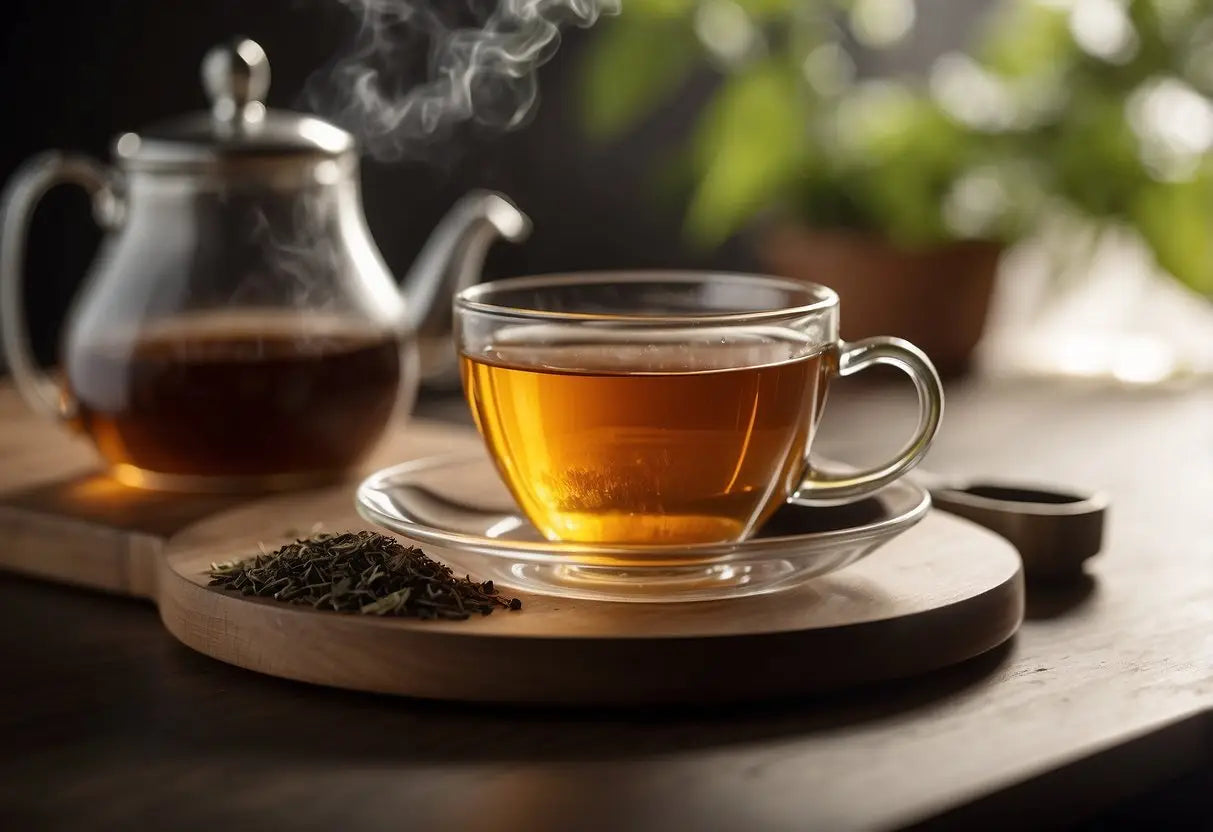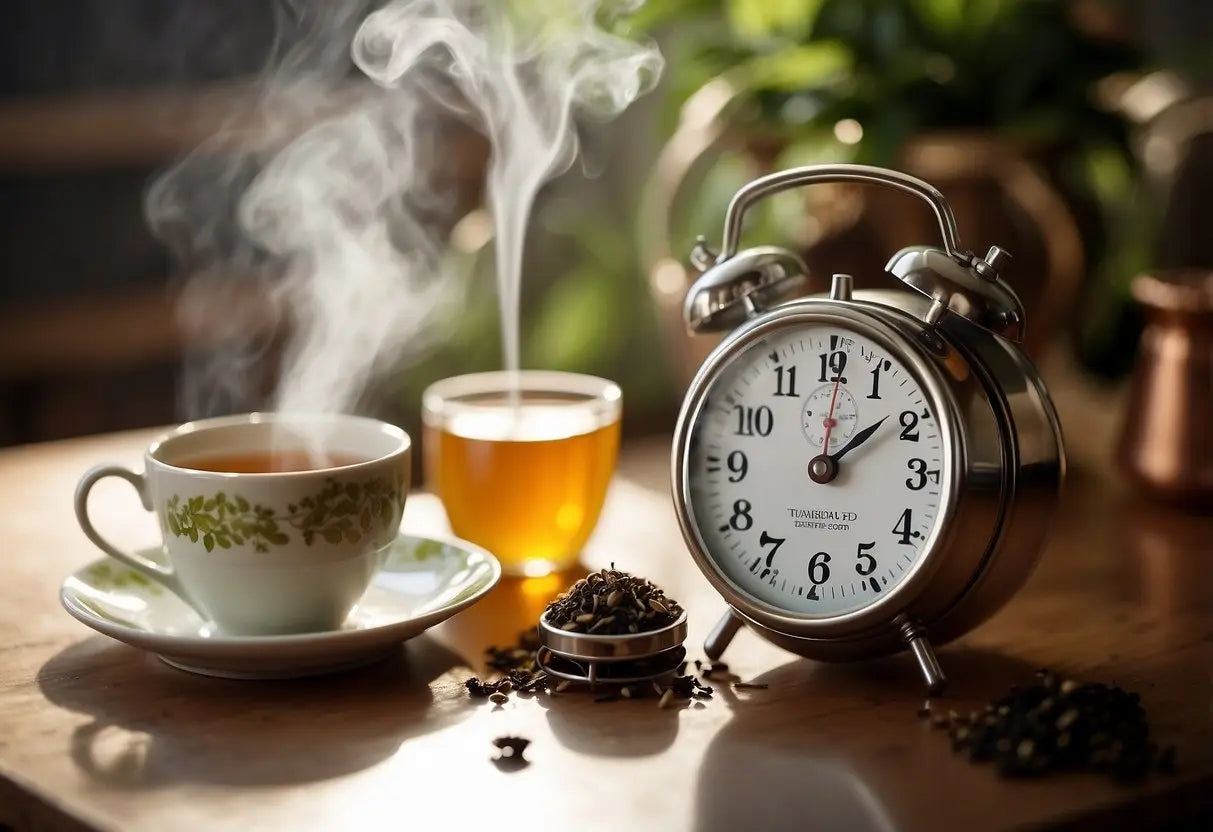How Long to Steep Tea
Steeping tea is an essential step in tea preparation, affecting both flavor and aroma. To master this process, you should know the optimal temperature, steeping time, and tea-to-water ratio.
Temperature: Different teas require specific water temperatures. For instance:
- Green tea: 160-180°F (71-82°C)
- Black tea: 200-212°F (93-100°C)
- Herbal tea: 208-212°F (98-100°C)
Steeping Time: The ideal steeping time varies:
Bestsellers
- Green tea: 1-3 minutes
- Black tea: 3-5 minutes
- Herbal tea: 5-7 minutes
Tea-to-Water Ratio: The traditional ratio is 1 teaspoon of tea leaves per 8 ounces of water.
Use this table for quick reference:
| Tea Type | Temperature (°F) | Steeping Time | Tea-to-Water Ratio |
|---|---|---|---|
| Green Tea | 160-180 | 1-3 minutes | 1 tsp per 8 oz |
| Black Tea | 200-212 | 3-5 minutes | 1 tsp per 8 oz |
| Herbal Tea | 208-212 | 5-7 minutes | 1 tsp per 8 oz |
Adjust based on your taste preferences. For stronger tea, increase the steeping time or use more leaves. For milder tea, decrease both.
Remember, patience and precision lead to the perfect cup.
Types of Tea and Steeping Times
Different teas require specific steeping times and temperatures to bring out their best flavors. Here are the recommended practices for common tea types.
Black Tea
Black tea has a robust flavor that develops with longer steeping times. Steep black tea for 3-5 minutes at a temperature of 200-212°F (93-100°C). This allows the tannins to release, giving the tea its signature strong taste. For a bolder brew, extend the steeping time closer to five minutes, but be cautious of over-steeping, which can cause bitterness.
Green Tea
Green tea is more delicate and can become bitter if steeped too long or in excessively hot water. Steep green tea for 2-3 minutes at 160-180°F (70-80°C). The lower temperature preserves its gentle flavors and beneficial compounds. Use a timer to avoid over-steeping and ensure a balanced taste profile.
White Tea
White tea features subtle, nuanced flavors and requires careful steeping. Steep white tea for 4-5 minutes at 175-185°F (80-85°C). Longer steeping times at moderate temperatures allow the light, sweet flavors to develop. Avoid boiling water, as it can scald the leaves and diminish the delicate taste.
Oolong Tea
Oolong tea combines characteristics of both black and green teas and offers a complex flavor profile. Steep oolong tea for 3-5 minutes at 180-200°F (82-93°C). The range of steeping times allows you to adjust for a lighter or more robust taste. Experiment within these parameters to find your preferred balance.
Herbal Tea
Herbal teas aren't technically teas but are commonly steeped in similar ways. Steep herbal tea for 5-7 minutes at 212°F (100°C). The longer steeping time extracts the flavors from the herbs, fruits, and flowers, producing a rich, aromatic beverage. Since herbal teas do not contain tannins, there's minimal risk of bitterness from longer steeping.
Water Temperature for Each Tea Type
Different teas require different water temperatures to achieve the best flavor and aroma.
Black Tea
- Temperature: 200-212°F (93-100°C)
- Use freshly boiled water for a robust flavor.
Green Tea
- Temperature: 150-180°F (65-80°C)
- Cooler water preserves the delicate flavors and prevents bitterness.
White Tea
- Temperature: 160-185°F (70-85°C)
- Slightly cooler than black tea to maintain its subtlety.
Oolong Tea
- Temperature: 180-200°F (82-93°C)
- Needs water hotter than green tea but cooler than black tea.
Herbal Tea
- Temperature: 205-212°F (96-100°C)
- Boiling water extracts the full range of flavors from herbs.
Pu-erh Tea
- Temperature: 200-212°F (93-100°C)
- Similar to black tea, boiling water is ideal.
Matcha
- Temperature: 175°F (80°C)
- Use cooler water to keep the vibrant color and avoid bitterness.
Rooibos
- Temperature: 200-212°F (93-100°C)
- Boiling water enhances its rich flavor.
By using the correct water temperature for each type of tea, you ensure the best possible tasting experience.
Lao Ban Zhang
Tea Steeping Techniques
Different teas require specific techniques for optimal flavor. Using the right method enhances your tea experience.
Time and Temperature
- Green Tea: 1-3 minutes at 160-180°F (71-82°C)
- Black Tea: 3-5 minutes at 200-212°F (93-100°C)
- Oolong Tea: 4-7 minutes at 180-200°F (82-93°C)
- White Tea: 4-5 minutes at 170-185°F (77-85°C)
- Herbal Tea: 5-7 minutes at 200-212°F (93-100°C)
Tools
Use quality tools for best results.
- Tea Kettle: Controls water temperature.
- Tea Infuser: Allows leaves to expand.
- Teapot: Ideal for steeping larger quantities.
Water Quality
Quality water affects taste. Use filtered or spring water when possible.
Tea Leaf Quantity
The amount of tea affects the strength.
- Standard: 1 teaspoon per 8 oz of water
- Strong: 1.5 teaspoons per 8 oz of water
Follow these guidelines to perfect your tea steeping techniques.
Adjusting Taste and Strength

To customize tea taste and strength, you can start by altering the steeping time. For a milder flavor, steep for a shorter period.
Conversely, a stronger tea requires a longer steeping time. Use the following general guidelines:
- Green Tea: 1-3 minutes
- Black Tea: 3-5 minutes
- Herbal Tea: 5-7 minutes
Adjusting water temperature also affects the taste.
- Green Tea: 160-180°F (70-80°C)
- Black Tea: 200-212°F (93-100°C)
- Herbal Tea: 212°F (100°C)
Consider the tea-to-water ratio. More tea leaves per cup result in a stronger brew. A common ratio is 1 teaspoon per 8 ounces of water, but 2 teaspoons make it more robust.
Experiment with these variables to find your perfect cup.
Common Steeping Mistakes
Using Water That's Too Hot: Boiling water can scorch delicate leaves, especially green or white tea. Instead, let the water cool slightly. Black teas thrive with boiling water, while green teas prefer around 175°F (80°C).
Over-Steeping: Leaving the tea bag or leaves in the water too long makes the tea bitter. Set a timer. Black tea generally needs 3-5 minutes, green tea 2-3 minutes, and white tea about 4-5 minutes.
Wrong Tea-to-Water Ratio: Using too much tea makes the brew too strong and using too little results in a weak flavor. A standard measure is one teaspoon of loose tea per cup of water. Adjust based on personal taste.
Ignoring Quality of Water: Tap water can affect the tea's taste. Filtered or spring water often works best. Avoid distilled water since the lack of minerals can make the tea taste flat.
Not Warming the Teapot: Pouring hot water into a cold teapot can affect the brewing temperature. Warm the pot with a little hot water before steeping.
Using Low-Quality Tea: The quality of the leaves greatly influences the flavor. Opt for high-quality loose leaf teas over cheap, prepackaged bags to enhance your tea experience.
Improper Storage: Tea should be stored in an airtight container away from light, moisture, and strong odors. Improper storage can lead to stale, flavorless tea.
Reusing Leaves Incorrectly: Some teas, especially high-quality ones, can be steeped multiple times. However, you should not reuse leaves too long after the first steeping, as they can lose flavor and increase the risk of microbial growth.
Tools and Accessories for Steeping Tea

When it comes to steeping tea, having the right tools can make all the difference. Teapots and tea kettles are essential. Teapots are used for brewing and serving, while tea kettles are used for boiling water.
Tea infusers and tea strainers are also crucial. They hold loose leaf tea and keep leaves out of your cup.
- Ball Infusers: Compact and easy to use.
- Basket Infusers: Ideal for mugs and teapots.
- Silicone Infusers: Fun shapes and easy to clean.
For those who prefer convenience, tea bags are another option. They contain pre-measured amounts of tea.
Tea timers help ensure consistent steeping times. Digital and sand timers are popular choices.
A thermometer ensures the right water temperature, vital for delicate teas.
Consider a tea cozy to keep your teapot warm. It maintains the tea's temperature longer.
With these tools and accessories, you can enhance your tea steeping experience and achieve the perfect cup every time.
Health Considerations During Steeping

When steeping tea, it's important to consider several health aspects to maximize benefits and minimize any potential risks.
Temperature Matters
Using water that's too hot can destroy some of the beneficial compounds in tea. Aim for temperatures between 160°F and 212°F, depending on the type of tea.
Steeping Time and Nutrients
Different steeping times can affect the nutrient extraction. Longer steeping will generally yield more antioxidants but can also increase caffeine and tannin levels.
Caffeine Content
For those sensitive to caffeine, shorter steeping times (1-2 minutes) can reduce caffeine exposure. Herbal teas typically contain less or no caffeine compared to black or green teas.
Possible Contaminants
Choose teas from reputable sources to avoid contaminants like pesticides and heavy metals. Organic options are a safer bet.
**Additives
Limit the use of sweeteners, milk, or lemon if you aim to preserve the natural health benefits of tea. Sugar and milk can alter the antioxidant activity.
Allergies and Sensitivities
Be cautious if you have allergies or sensitivities. Some teas contain ingredients that could trigger reactions, such as spices or flower petals.
| Type of Tea | Optimal Steeping Time | Temperature |
|---|---|---|
| Green Tea | 2-3 minutes | 160-180°F |
| Black Tea | 3-5 minutes | 200-212°F |
| Herbal Tea | 5-7 minutes | 200-212°F |
Pay attention to these factors to make the healthiest cup of tea possible.
← Older post Newer post →











